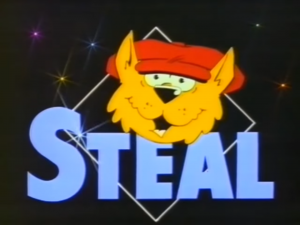Steal
Contents |
Host
Wayne Dobson (non-broadcast pilot)
Mark Walker
Co-hosts
Voiceover: Stephen Rhodes
Broadcast
Central for ITV, 17 February to 12 May 1990 (12 episodes in 1 series)
Synopsis
Not to be confused with that awful Paul Hendy should-be-on-radio-but-they-have-the-audacity-to-use-it-as-a-bumper show (Stash), this rightly had little success on Saturday night, but if anyone reading this wants to remake it for a, say, weekday 5:30 ITV slot, that would be fine by us.
Two teams of two (seated one above the other, in true Blankety Blank-style) tried to win as much cash as possible by picking squares, Pelmanism-style (shades of Concentration, Four Square and Memory Bank here) off a 4x4 computerised board. And that's it. AND YET! It isn't, for this is a memory game with a twist - literally - and that's why we kind of like it.
For a start, the contestants were given 10 seconds (5 in Round 2) to memorise where everything is on the board. Then, and here's the explanation on the clever wordplay in the above paragraph, the board would then go blank so all the squares were hidden and then the grid would turn through 90 degrees (180 degrees in Round 2) so the players needed to have a good memory and fine mental agility skills if they wanted to win. They were given a category of square to find every time - and if they found the wrong category, the square became, as Mark put it, 'a dead square', or if it was a penalty square, the contestants would normally lose some money as a result.
The squares themselves had quite a bit of variety too. The main 'character' of the show was a burglar called Jools who stunningly was also a cat (respect to whoever thought up the cat burglar idea). Some squares bearing a pound sign started a sort of Roulette thing where the player currently playing would stop a flashing totaliser which was randomly flashing cash values which would be added to their stash. There were also red pound sign squares (used only in the second round), in which the contestants needed to hit a zero, otherwise they'd lose the amount of money they landed on. In addition, there were 'Swag' squares, which could win the contestants mystery prizes - not that that was necessarily a good thing, however, as some of the prizes were of the 'joke' variety, such as a 'twenty-piece dinner service', which was actually several items of broken crockery.
Then there would bad squares which would show the ultimate humiliation of the cat becoming a 'jailbird', as well, which would lose them money (although only in the second round), as would the red pound signs. Then there were the excellent First Class style computer games. One of the games was called "Laundered Lolly" where Jools (the cat burglar) had to grab pound notes out the sky (Grab-A-Grand style) and peg them on a washing line. This game was so hard that very few contestants ever won much on it...
Round 2 was played for double cash (a familiar idea, though this show wasn't by double-cash-master Stephen Leahy) and the winning team went through to round three where they played for £3000. Only one of the winners would play this round and he/she had a maximum of 8 moves to play with, within a minute. There were 5 squares that they needed to find in any order so that they could win the jackpot (the key, the bank, the alarm, the vault and the safe). There were also 6 squares containing extra cash amounts and 5 'police' squares (or 'The Bill', as Walker tended to call them) that would each lose the contestant 5 seconds of his/her allotted time if accidentally revealed. They had 5 seconds to remember the positions, then the grid would turn so that the inner 4 squares went 180 degrees one way and the 12 outer squares would rotate 90 degrees the other way - so as to really confuse the contestants. Although the extra cash amounts were well worth having, it was always best for the contestants to concentrate on getting the 5 main squares, given that they only had 8 moves in which to do it and finding too many of the other squares (especially the police ones) would mean that they could not hit the jackpot.
A show with a sense of humour then (even if it was hosted by Roy Walker's son - arf!) and had some good fun moments.
Catchphrases
(Contestants): "Up to the top and steal".
(Walker): "And steal that square - is it cash (or whatever) - no, it's swag, so that becomes a dead square and won't come back into play..."
"...Yes, it's Jools, our very own burglar cat..."
"...And the jail squares - these are to be avoided at all costs, as cool cats don't make good jailbirds..."
"...It's a jail square - be careful of those in the next round, because they'll be costing you a fiver..."
"You've got ten (or five, depending on the round) seconds to remember exactly what you saw and where you saw it - ten seconds, starting...now".
"You've got the zilcho sound..." (if a contestant failed to get any money on a cash square).
Inventor
Ian Messiter and his 14-year-old grandson, James Beaumont. They demoed the principle to Central TV bosses on that workhorse of 1980s game shows, the BBC Model B. (Note: the end credits of the pilot show say that James is Messiter's "nephew", which isn't correct.)
Tony Wolfe and Dennis Liddington are credited with the television adaptation of the idea; Liddington also served as the show's producer.
Theme music
Mike Alexander, credited as "Musical Director".
Web links
Videos
A full episode from the show.


